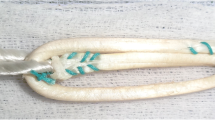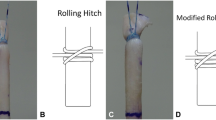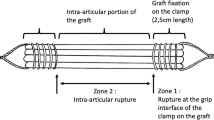Abstract
Purpose
To investigate two different methods of suture fixation and tendon behaviour when using an Endobutton and a tripled tendon.
Methods
Thirty bovine tendons and foam blocks were randomly allocated to three groups: group 1: The tendon was doubled through 40-mm Endobutton; group 2: Tripled tendon—whip-stitched with No. 2 Ultrabraid, passed through an Endobutton and third limb secured to the loop via seven knots; and group 3: Tripled tendon—whip-stitched with No. 2 Fibreloop and fixed as group 2. A tunnel matching the graft diameter was drilled through the block. The graft was passed through the tunnel and fixed with an interference screw. The constructs were cycled at 1 Hz from 10 to 50 N for 10 cycles followed by 50–250 N at 1 Hz for 500 cycles. Load-to-failure test was then carried out at a rate of 20 mm/min. A custom digital image capture technique was used to measure and calculate displacement, strain and stress. Statistical analysis was carried out using Kruskal–Wallis test and paired t test.
Results
There was no statistical significant difference between ultimate tensile strength (UTS) (P = 0.35) and yield load (0.41) between the 3 groups. The mean displacement of the third tendon limb in group 2 was 4.8 mm and in group 3, 1.5 mm. Displacement was not statistically significant (P = 0.07). The mean stress in the third limb versus the doubled portion of tendon in group 2 was 0.4 ± 0.02 versus 4.8 ± 0.52 MPa and in group 3, 0.5 ± 0.03 versus 5.2 ± 0.52 MPa.
Conclusions
In this biomechanical study, there was no mechanical difference in the overall properties between a doubled and tripled tendon graft. Significant cyclic elongation occurred in the third limb of the tripled tendon in comparison with the doubled portioned. Further work is needed to determine whether these mechanical findings translate to clinical practice. Caution should be used when tripling hamstring grafts. In particular, tripling small grafts provides no biomechanical advantage immediately and possibly long term, thus potentially increasing the risk of failure.



Similar content being viewed by others
References
Beynnon BD, Amis AA (1998) In vitro testing protocols for the cruciate ligaments and ligament reconstructions. Knee Surg Sports Traumatol Arthrosc 6(Suppl 1):S70–S76
Cheung W, Mahmud J, Evans S, Holt C, Snow M, Wang B, Chizari M (2010) Evaluating the Mechanical Properties of a Tendon Graft, Using Digital Image Correlation (DIC) Technique. J Biomech 43(Supp1):S63
Evans S, Holt CA (2009) Measuring the mechanical properties of human skin in vivo using digital image correlation and finite element modelling. J Strain Anal Eng 44:337–345
Ferretti A, Monaco E, Labianca L, De Carli A, Maestri B, Conteduca F (2009) Double-bundle anterior cruciate ligament reconstruction: a comprehensive kinematic study using navigation. Am J Sports Med 37:1548–1553
Gao Z, Desai JP (2010) Estimating zero-strain states of very soft tissue under gravity loading using digital image correlation. Med Image Anal 14:126–137
Guana E, Smilowb S, Rafailovicha M, Sokolova J (2004) Determining the mechanical properties of rat skin with digital image speckle correlation. J Dermatol 208:112–119
Izawa T, Okazaki K, Tashiro Y, Matsubara H, Miura H, Matsuda S, Hashizume M, Iwamoto Y (2011) Comparison of rotatory stability after anterior cruciate ligament reconstruction between single-bundle and double-bundle techniques. Am J Sports Med. doi:10.1177/0363546510397172
Jin T, Goo NS, Woo SC, Park HC (2009) Use of a digital image correlation technique for measuring the material properties of beetle wing. J Bionic Eng 6:224–231
Katouda M, Soejima T, Kanazawa T, Tabuchi K, Yamaki K, Nagata K (2011) Relationship between thickness of the anteromedial bundle and thickness of the posterolateral bundle in the normal ACL. Knee Surg Sports Traumatol Arthrosc. doi:10.1007/s00167-011-1417-0
Kondo E, Yasuda K, Azuma H, Tanabe Y, Yagi T (2008) Prospective clinical comparisons of anatomic double-bundle versus single-bundle anterior cruciate ligament reconstruction procedures in 328 consecutive patients. Am J Sports Med 36:1675–1687
Kousa P, Järvinen TLN, Vihavainen M, Kannus P, Jarvinen M (2003) The fixation strength of six different hamstring graft fixation devices in anterior cruciate ligament reconstruction. Part I, femoral site. Am J Sports Med 31:174–181
Lehmann AK, Osada N, Zantop T, Raschke MJ, Petersen W (2009) Femoral bridge stability in double-bundle ACL reconstruction: impact of bridge width and different fixation techniques on the structural properties of the graft/femur complex. Arch Orthop Trauma Surg 129:1127–1132
Maeda E, Asanuma H, Noguchi H, Tohyama H, Yasuda K, Hayashi K (2009) Effects of stress shielding and subsequent restressing on mechanical properties of regenerated and residual tissues in rabbit patellar tendon after resection of its central one-third. J Biomech 42:1592–1597
Mahmud J, Holt CA, Evans SL (2010) An innovative application of a small-scale motion analysis technique to quantify human skin deformation in vivo. J Biomech 43:1002–1006
Majima T, Yasuda K, Yamamoto N, Kaneda K, Hayashi K (1994) Deterioration of mechanical properties of the autograft in controlled stress-shielded augmentation procedures: an experimental study with rabbit patellar tendon. Am J Sports Med 22:821–829
Malinin TI, Levitt RL, Bashore C, Temple HT, Mnaymneh WA (2002) Study of retrieved allografts used to replace anterior cruciate ligaments. Arthroscopy 18:163–170
Moerman KM, Holt CA, Evans SL, Simms CK (2009) Digital image correlation and finite element modelling as a method to determine mechanical properties of human soft tissue in vivo. J Biomech 42:1150–1153
Muneta T, Koga H, Mochizuki T, Ju YJ, Hara K, Nimura A, Yagishita K, Sekiya I (2007) A prospective randomized study of 4-strand semitendinosus tendon anterior cruciate ligament reconstruction comparing single-bundle and double-bundle techniques. Arthroscopy 23:618–628
Park SJ, Jung YB, Jung HJ, Jung HJ, Shin HK, Kim E, Song KS, Kim GS, Cheon HY, Kim S (2010) Outcome of arthroscopic single-bundle versus double-bundle reconstruction of the anterior cruciate ligament: a preliminary 2-year prospective study. Arthroscopy 26:630–636
Siebold R, Dehler C, Ellert T (2008) Prospective randomized comparison of double-bundle versus single-bundle anterior cruciate ligament reconstruction. Arthroscopy 24:137–145
Singhal MC, Gardiner JR, Johnson DL (2007) Failure of primary anterior cruciate ligament surgery using anterior tibialis allograft. Arthroscopy 23:469–475
Siebold R, Branch TP, Freedberg HI, Jacobs CA (2011) A matched pairs comparison of single- versus double-bundle anterior cruciate ligament reconstructions, clinical results and manual laxity testing. Knee Surg Sports Traumatol Arthrosc. doi:10.1007/s00167-011-1475-3
Thompson MS, Schell H, Lienau J, Duda GN (2007) Digital image correlation: a technique for determining local mechanical conditions within early bone callus. Med Eng Phys 29:820–823
Viceconti M, Cappello A, Toni A (1996) Mechanical validation of whole bone composite femur models. J Biomech 29:525–535
Zantop T, Weimann A, Wolle K et al (2007) Initial and 6 weeks postoperative structural properties of soft tissue anterior cruciate ligament reconstructions with cross-pin or interference screw fixation: an in vivo study in sheep. Arthroscopy 23:14–20
Zhang D, Arola DD (2004) Applications of digital image correlation to biological tissues. J Biomed Opt 9:691–699
Acknowledgments
We would like to thank The Royal Orthopaedic Hospital Charity for their financial support to the study.
Author information
Authors and Affiliations
Corresponding author
Rights and permissions
About this article
Cite this article
Snow, M., Cheung, W., Mahmud, J. et al. Mechanical assessment of two different methods of tripling hamstring tendons when using suspensory fixation. Knee Surg Sports Traumatol Arthrosc 20, 262–267 (2012). https://doi.org/10.1007/s00167-011-1619-5
Received:
Accepted:
Published:
Issue Date:
DOI: https://doi.org/10.1007/s00167-011-1619-5




